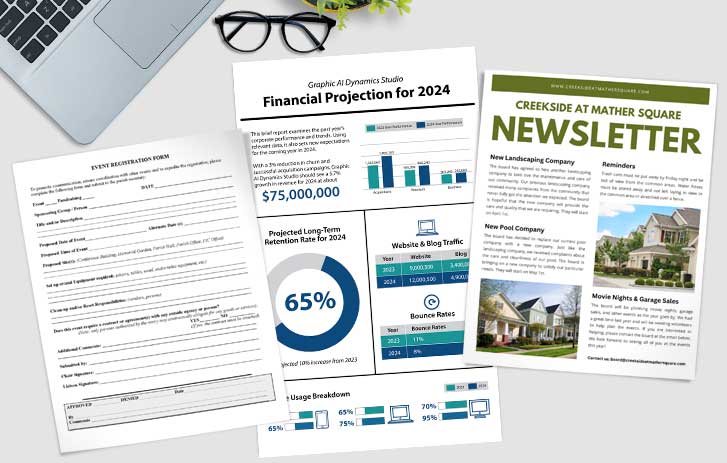In this digital age, businesses might be inclined to believe that going paperless is the most sustainable option—but that’s not necessarily true. Electronics create their own waste, and, according to a United Nations estimate, less than 25% of all U.S. e-waste is recycled.¹ Paper, however, is recycled easily and often, at 66%²—making it a sustainable choice for businesses that want to leave a positive impact on the planet and reach the growing number of environmentally conscious customers.
As consumers become more and more concerned about sustainability, companies need to know how their business decisions impact the world around them and affect their industry’s future. Where does paper fit into your company’s sustainability goals? Here are six myths about paper, and why it’s a sustainable business choice for your organization.
Myth No. 1: Paper is wasteful Buster:
There is a widespread misconception that paper equals waste; in reality, it is one of the most renewable and easily recycled products in the world. In North America, where recovery rates top 66%, paper is recycled more than any other material.² Compared to just about any other material, paper is easy to reuse and recycle—and companies do. Approximately 46 million tons of paper and paperboard products are recycled in the United States every year,³ including nearly 5,000 tons of paper recycled annually through the FedEx Office customer confidential drop-off shredding services. According to a recent study by the American Forest & Paper Association, around 40% of the fiber used in papermaking in the U.S. comes through recovered paper.4 The rest comes from recovered fiber, wood chips, sawmill residues, and trees.5
Myth No. 2: Paper is only sustainable if it’s recycled Buster:
Seeing a “100% recycled” label on a ream of printer paper can be a strong lure. But while collecting and recycling paper is great for the environment, recycled paper couldn’t exist without virgin paper. Every time paper is recycled, the fibers degrade a little bit more, which limits how many times a sheet of paper can be recycled. Paper can be recycled many more times than plastic, but a continuous supply of fresh fiber is still needed to keep the paper life cycle going—and that supply can be harvested sustainably.
Myth No. 3: Going paperless saves forests Buster:
Sustainably managed forests—where much of the U.S.’s paper comes from, and nearly 100% of the paper purchased by FedEx Office—are key to our planet’s survival. Sustainable forest management, according to the Food and Agriculture Organization of the United Nations, aims to maintain the “economic, social, and environmental values of all types of forests” while optimizing their benefits.6 This means mimicking natural patterns of disturbance and regeneration within forests, preserving biodiversity, and using reduced-impact logging techniques, among other approaches. When these sustainable forestry tactics are used, paper consumption does not destroy forests but rather helps maintain them and keeps overgrowth in check.
Myth No. 4: Paper is bad for the environment Buster:
Due to sustainable forestation practices, paper can actually contribute to the survival and growth of forests that help regulate global climate, absorb carbon emissions from the atmosphere and produce the oxygen we need to live. According to the Intergovernmental Panel on Climate Change, forests currently absorb a quarter of the fossil fuel emissions that humans produce. That’s about 10 billion tons of CO2 a year.7 By absorbing CO2, forests, which the paper cycle aids in regulating, help reduce global warming and dramatically lessen its effects—a fact embraced by organizations such as the Arbor Day Foundation, which advocates for planting trees as one of the most effective ways to combat climate change.8 See Myth Buster No. 5 to learn how paper production supports sustainable forest management—keeping these forests intact, and even helping them grow.
Myth No. 5: More paper means fewer trees Buster:
People often think of the lumber industry as a zero-sum game: The more paper we consume, the fewer trees in our forests. However, done responsibly, paper production actually contributes to the maintenance and even expansion of this country’s forests. The United States consumes more paper products than many other parts of the world, and yet our forests continue to grow. Between 2005 and 2015, U.S. forests increased by about 1.3 million acres a year—the equivalent of 2,740 football fields a day.9 This growth is dependent on the sustainable practices that have become the norm throughout the industry. In the U.S., we grow many more trees than we harvest, with an average net increase of about 25 billion cubic feet a year.10
Myth No. 6: Paper causes deforestation Buster:
The world’s deforestation is caused by many factors, from urbanization to agriculture. Paper production, on the other hand, encourages landowners—many of whom might sell their land for development or other non-forest purposes—to continue planting and harvesting trees. According to the U.S. Forest Service, more than 90% of the wood and paper products consumed in the U.S. comes from private landowners.11 Receiving income for wood products grown on their land provides a major incentive to maintain forests and engage in responsible and sustainable harvesting practices. Many of the factors that contribute to deforestation in other parts of the world are expressly prohibited by a host of regulatory organizations and federal laws in the U.S. In addition, third-party certification organizations establish standards that promote responsible and sustainable harvesting,12 requiring protection of old growth areas and ensuring that forest growth meets or outpaces harvesting. Sustainability has never been more important to your business and brand—and working with a sustainability-focused printer will help ensure that your print programs are environmentally sound. Making informed decisions about paper requires separating fact from long-held myths. At FedEx Office, we can help ensure that your company has all the information it needs to make smart decisions that will advance your sustainability goals.
Sources
1. TIME (May 23, 2019). “The World Has an E-Waste Problem.”
2. American Forest & Paper Association (May 12, 2020). “U.S. Paper Industry Achieves Consistently High Recycling Rate.”
3. Environmental Protection Agency (2018). “Paper and Paperboard: MaterialSpecific Data.”
4. Two Sides (2020). “Wood fiber from sustainably managed forests is essential to the paper cycle.”
5. Two Sides (2020). “Print and Paper: The Facts.”
6. Food and Agriculture Organization of the United Nations (2020). “Sustainable forest management.”
7. Climate and Land Use Alliance (2021). “Five Reasons The Earth’s Climate Depends On Forests.”
8. Arbor Day Foundation (2020).
9. U.S. Department of Agriculture (2017). “Considering Forest and Grassland Carbon in Land Management.”
10. Two Sides (2018). “In North America, we grow many more trees than we harvest.”
11. American Forest & Paper Association (2020). “2020 AF&PA Sustainability Report.”
12. Food and Agriculture Organization of the United Nations (2021). “Forest Certification.”






















